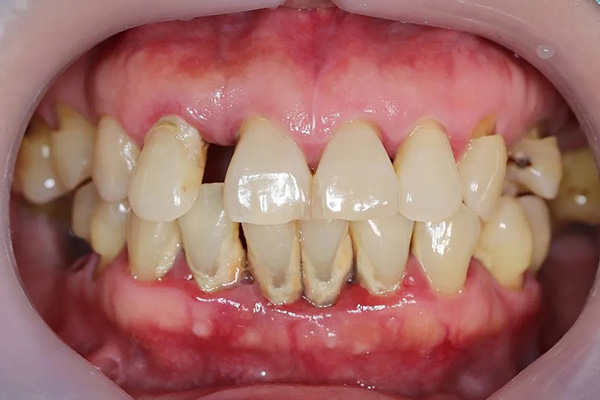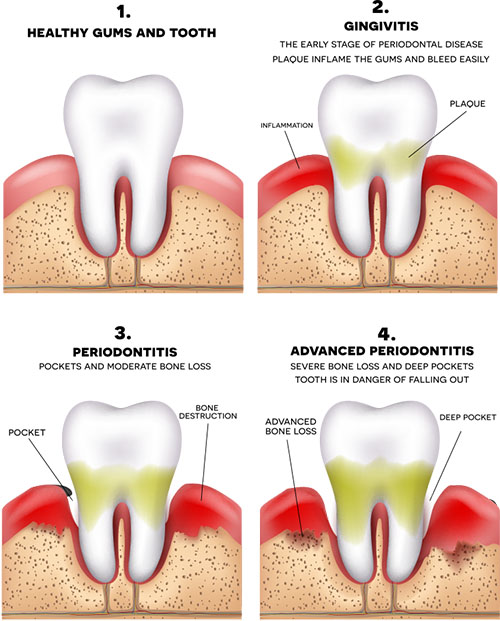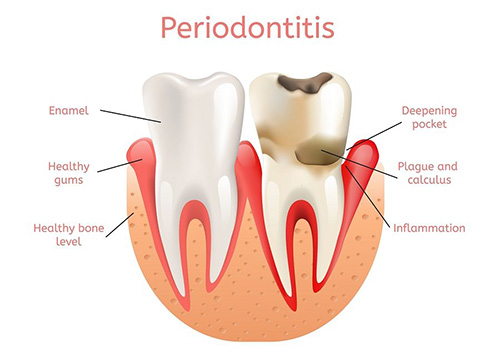Periodontitis (Gum Disease): Symptoms, Causes, and Treatments

What is Periodontitis?
Periodontitis, often known as gum disease, is a common infection that harms the bone and soft issue supporting the teeth. The alveolar bone around the teeth will gradually deteriorate if not treated.
Stages of Periodontitis
Periodontitis begins with inflammation and progresses over time.

Inflammation (gingivitis)
Gingivitis is a gum infection caused by periodontitis. Gum bleeding during tooth brushing or flossing is an indication of gingivitis.
You may also notice some tooth discoloration. It’s referred to as a plaque. On your teeth, plaque is a deposit of germs and food particles. Even while you always have bacteria in your mouth, issues only arise when their population expands quickly. This could happen if you don’t frequently floss, brush your teeth, or get your teeth cleaned.
You may also notice some tooth discoloration. It’s referred to as a plaque. On your teeth, plaque is a deposit of germs and food particles. Even while you always have bacteria in your mouth, issues only arise when their population expands quickly. This could happen if you don’t frequently floss, brush your teeth, or get your teeth cleaned.
Early periodontal disease
Small pockets develop between the gums and teeth in the early stages of periodontitis, and your gums pull back from your teeth. The pockets contain dangerous microorganisms. Your gum tissue begins to erode as your immune system struggles to combat the infection. Additionally, you can have minor bone loss and bleeding while flossing and brushing your teeth.
Moderate periodontal disease
You can have bleeding, pain, and gum recession if moderate periodontal disease is allowed to progress. Your teeth will start to grow loose and lose their bone support. Additionally, the infection may cause inflammation to spread throughout your body.
Advanced periodontal disease
In advanced disease, the connective tissue that holds your teeth in place begins to degenerate. Gums, bones, and other tissues that support your teeth are lost. If your periodontitis is advanced, you can have terrible breath, a bad taste in your mouth, and severe discomfort when you chew. Your teeth are prone to falling out.
Symptoms of Periodontitis
Your teeth should fit tightly around healthy gums, which are firm to the touch. In comparison, periodontitis symptoms include:
- Soft gums.
- Bad breath.
- Infection or pus along your gum line.
- Tooth decay.
- Difficulty chewing.
- Reddish or purplish gums.
- Swollen gums.
- Bleeding gums.
- Receding gums
- Build-up of plaque or tartar on your teeth
- Foul taste in your mouth

Causes of Periodontitis
The main cause of periodontal disease is bacterial plaque, a sticky, white film that forms over the surface of teeth.
Plaque is removed by brushing, but it will reappear in a day or so.
Remaining plaque will harden into calculus, also known as tartar. Plaque is easier to remove than tartar. Tartar cannot be eliminated at home. Professional care is required.
Tartar and plaque can gradually harm the tissue around the teeth.
Gingivitis may initially manifest. The gums at the base of the teeth are inflamed, although this can be reversed.
Between the teeth and gums, pockets may form if gingivitis is left untreated. The bacteria accumulate in these pockets.
Bacterial toxins begin damaging the bone and connective tissue that hold teeth in place as the immune system reacts to tartar build-up. The teeth eventually start to become loose and may even fall out.
An interactive 3-D model of periodontal disease can be found below.
To learn more about periodontal disease, explore the model using your mouse pad or touchscreen.
Plaque is removed by brushing, but it will reappear in a day or so.
Remaining plaque will harden into calculus, also known as tartar. Plaque is easier to remove than tartar. Tartar cannot be eliminated at home. Professional care is required.
Tartar and plaque can gradually harm the tissue around the teeth.
Gingivitis may initially manifest. The gums at the base of the teeth are inflamed, although this can be reversed.
Between the teeth and gums, pockets may form if gingivitis is left untreated. The bacteria accumulate in these pockets.
Bacterial toxins begin damaging the bone and connective tissue that hold teeth in place as the immune system reacts to tartar build-up. The teeth eventually start to become loose and may even fall out.
An interactive 3-D model of periodontal disease can be found below.
To learn more about periodontal disease, explore the model using your mouse pad or touchscreen.
Treatment
The purpose of treatment is to remove germs from the pockets surrounding the teeth and stop further bone and tissue damage.
Good oral hygiene
Cleaning your teeth at least twice a day is recommended
- Once a day, floss and use interdental brushes or soft picks.
- At least once a year, visit the dentist.
- Avoiding using tobacco.
- Minimising alcohol and sugar-added meal intake.
- Seek dental or medical care if you have a dry mouth, changes in taste or smell, or other mouth issues.
Scaling and cleaning
Plaque and calculus removal can aid in regaining periodontal health.
A variety of medicated mouthwashes and other therapies are available. If other therapies are ineffective, a dentist may advise periodontal surgery.
- Cleaning the surfaces of the teeth above the gum line and in the pockets with scaling and debridement.
- Polishing to smooth rough surfaces on the teeth, which aids in plaque removal.
- Fluoride treatment of the teeth
A variety of medicated mouthwashes and other therapies are available. If other therapies are ineffective, a dentist may advise periodontal surgery.
When to see a dentist
A person has to visit a doctor or dentist if they have:
These signs may require immediate medical attention or additional testing to rule out other conditions, including mouth cancer or an abscess.
- Gums that bleed after brushing or eating a hard food
- Gums that are swollen, red, or hurt
- Poor breath
- Crooked teeth
- Mouth ulcers or reddened areas
- A bump on the lip or in the mouth
These signs may require immediate medical attention or additional testing to rule out other conditions, including mouth cancer or an abscess.

